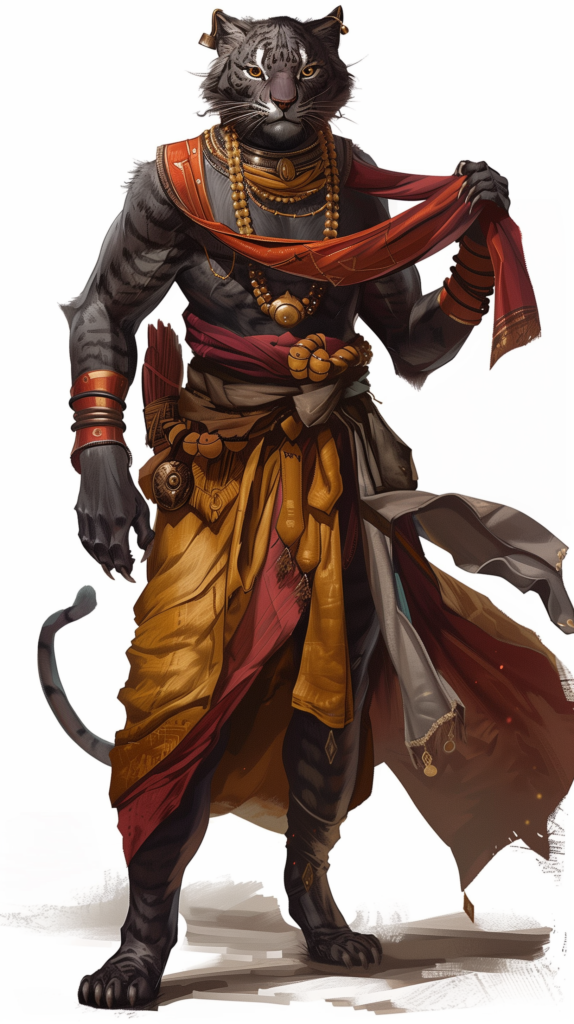Rakshasa
“Unveiling the Mysterious and Sinister World of Rakshasas – Ancient Evils and Cunning Shapeshifters?”
Rakshasas are born on the Material Plane, but they are not of it. They possess the powers and shapes of fiends, but their fates are inexorably tied to the mortal world, and it is there that they seek to rule. The reincarnations of manipulators, traitors, and tyrants obsessed with earthly pleasures, rakshasas are the embodiments of the very nature of materialistic evil. After dying violent deaths, these spirits are so tied to worldly decadence and selfish concerns that they take shapes that better reflect the baseness of their lives and are reborn as fiends. Thus have sages come to know these beings as the “earthbound evils.”

While there are many different types of rakshasas, from the lowly raktavarna to the powerful maharaja, the most commonly encountered are not known by any other name—they are more powerful than some members of their kind and less powerful than others, and represent the ideal midpoint between servitor and master. These rakshasas can be recognized by their animal heads (those of great cats, snakes, crocodiles, apes, and birds of prey being the most common) and backward-facing hands. Feral traits and strangely reversed joints are a hallmark of all types of rakshasas, in fact, features that most rakshasas can hide through their supernatural ability to change shapes or by means of powerful illusions.
A rakshasa cannot impregnate another of its own kind, and so new rakshasas come into being via the coupling of a rakshasa and a non-rakshasa or, rarely, that of two non-rakshasas. A rakshasa born to non-rakshasa parents generally only occurs when one or both of the parents commits a great evil during the mother’s pregnancy, allowing the disembodied spirit of a previously slain rakshasa to reincarnate into the world by usurping the unborn offspring’s body.
Rarely, such blasphemous births afflict good or innocent parents, typically in cases where the parents are exposed to great evils beyond their control. A rakshasa grows to maturity more quickly than a human, and often functions as a full-grown adult earlier than age 14. Despite this quick maturation, a rakshasa can live for 500 years or more before dying, at which point its spirit seeks a new host to be reborn in, continuing the vile cycle of fiendish reincarnation over and over again.
Rakshasas believe that each and every creature in the universe has a proper role to play, and that success comes from understanding one’s position and working to improve it. Rakshasas don’t see castes as good or evil, but rather as purely pragmatic. Creatures of higher caste should be respected for their great power, and those oflower caste should be pressed into willing service to expand the holdings of those of higher castes as their betters seek greater wealth and influence.
There are seven castes in rakshasa society (from lowest to greatest): pagala (traitors), goshta (food), adhura (novices), darshaka (servants), paradeshi (rakshasa-kin), hakima (lords), and samrata (lords oflords). The rakshasa caste system encompasses not just all of rakshasa society, but all of life—although only rakshasas can attain the stations of darshaka and above.
While rakshasas are forced to admit that the gods have powers greater than their own, most rakshasas scoff at the concept of divinity as a whole. The gods are among the most powerful beings in existence, to be sure, but too many examples of powerful, ambitious, or merely lucky mortals attaining divinity exist for rakshasas to pay religious homage to such creatures. Rakshasas see their own transitions from mortals to otherworldly beings as marks of their own fathomless potential and their initial steps on the path to godhood. Thus, as a race, rakshasas deny the worship of deities, although they welcome alliances with the servants of such peerlessly potent beings when it serves their purposes.
The skin of a rakshasa is remarkably resistant to physical damage, able to ignore or greatly reduce most weapon attacks. Holy weapons capable of piercing this skin, however, can reach a rakshasa’s vitals and do significant damage. As a result, in lands where their kind are well known, rakshasas take great pains to disguise themselves with magic when they are among enemies.
Rakshasa Immortals
The rakshasa immortals are rakshasas who have ascended beyond mortality—they are no longer bound to the cycle of reincarnation and rebirth most rakshasas endure, and are truly immortal. Such creatures, given the span of countless lifetimes to perfect their art and master their cruelties, approach the power of gods.
- Aksha of the Second Breath
- Bundha the Singing Butcher
- Caera the Blood Bather
- Dradjit the Godslayer
- Hudima the Kinslayer
- Jyotah, He Who Walks Among the Gods
- Kunkarna the Dream Warrior
- Mursha the Beastmaster
- Otikaya the Spirit Archer
- Prihasta, General Between Heaven and Hell
- Ravana, The First and Last
- Surpa the Avenger
- Vibhishah the Seeker
- Zabha the Desecrator
Section 15: Copyright Notice
Pathfinder Roleplaying Game Bestiary 3, © 2011, Paizo Publishing, LLC; Authors Jesse Benner, Jason Bulmahn, Adam Daigle, James Jacobs, Michael Kenway, Rob McCreary, Patrick Renie, Chris Sims, F. Wesley Schneider, James L. Sutter, and Russ Taylor, based on material by Jonathan Tweet, Monte Cook, and Skip Williams.

 Buy me a coffee
Buy me a coffee